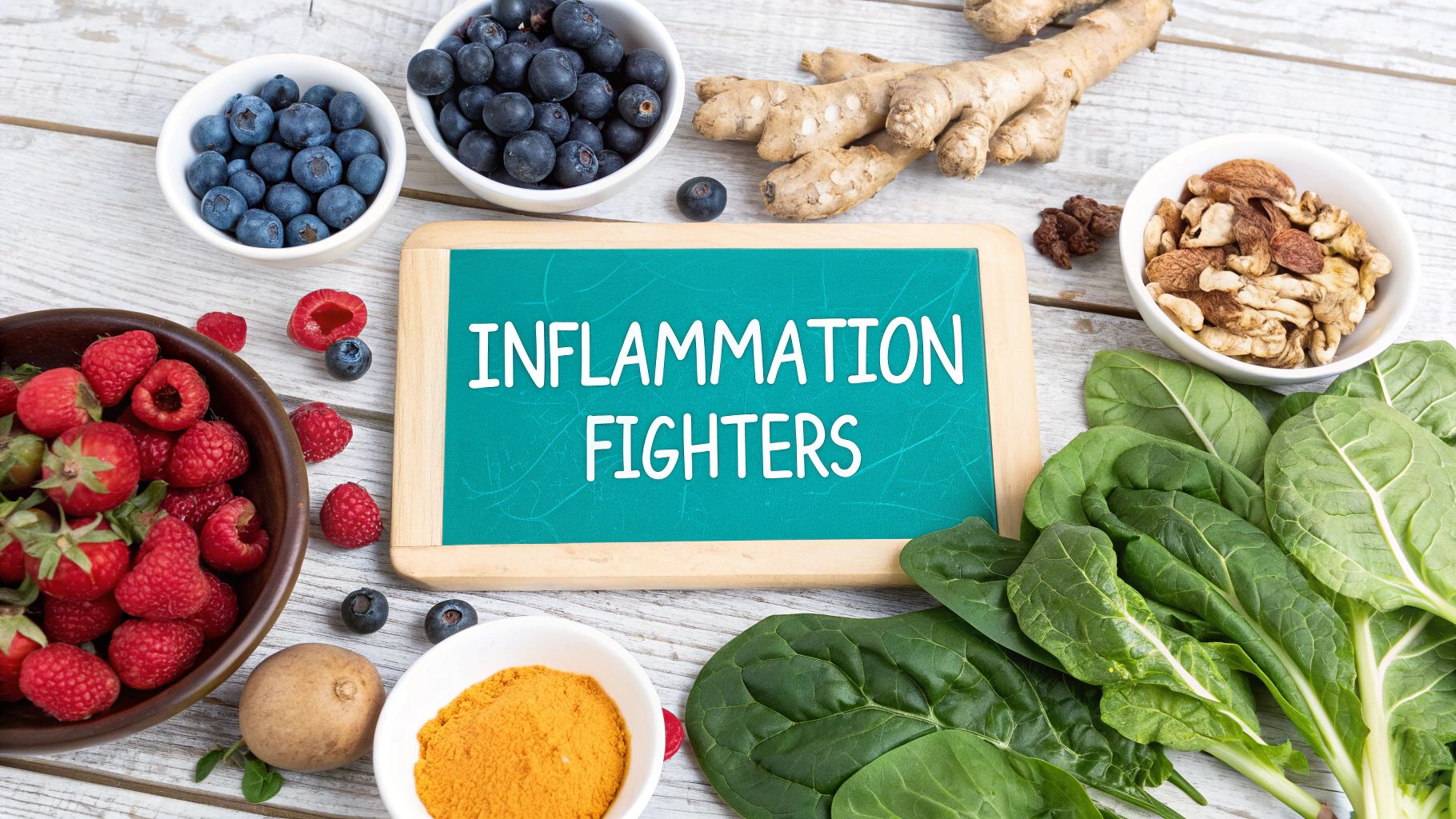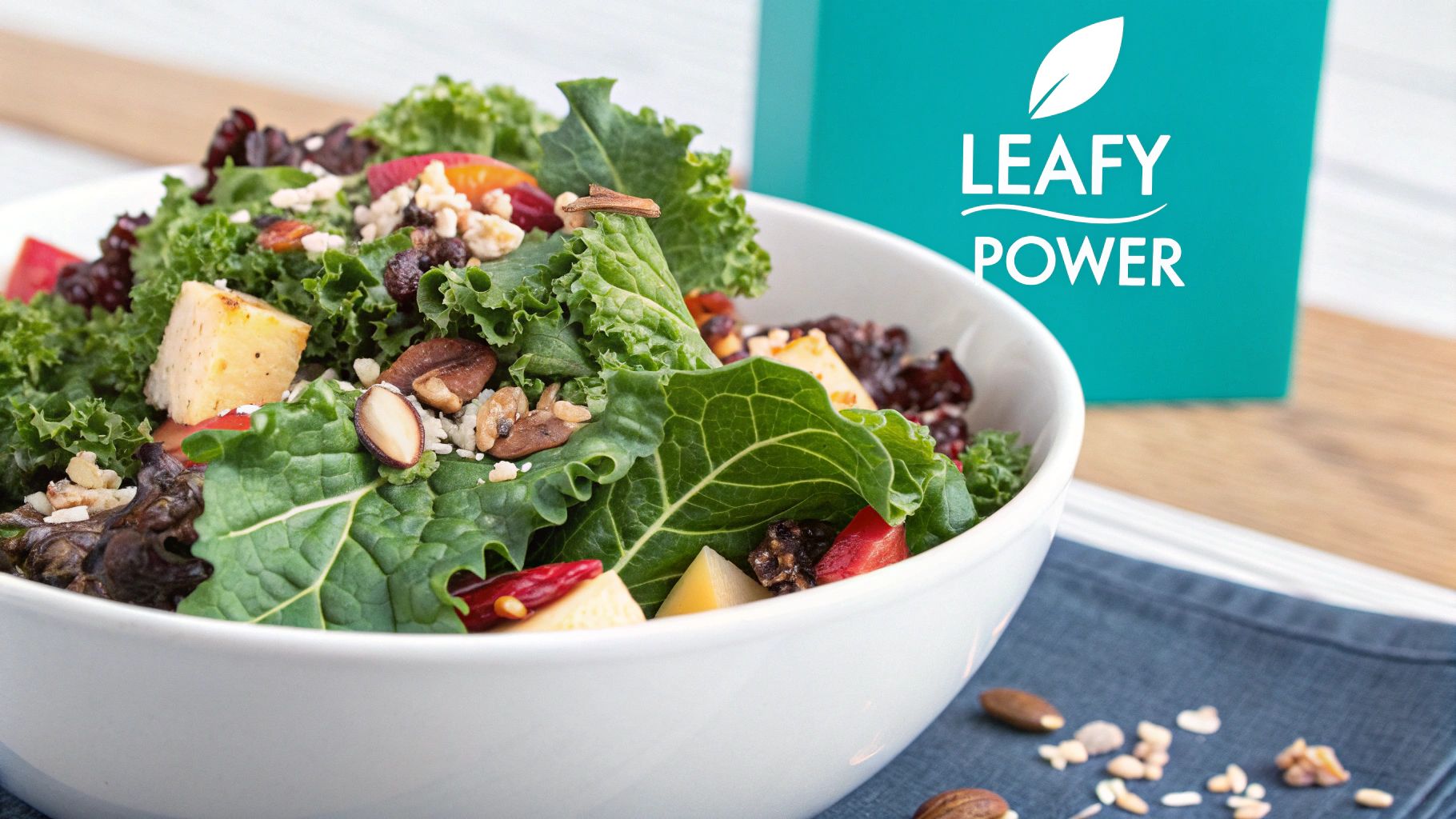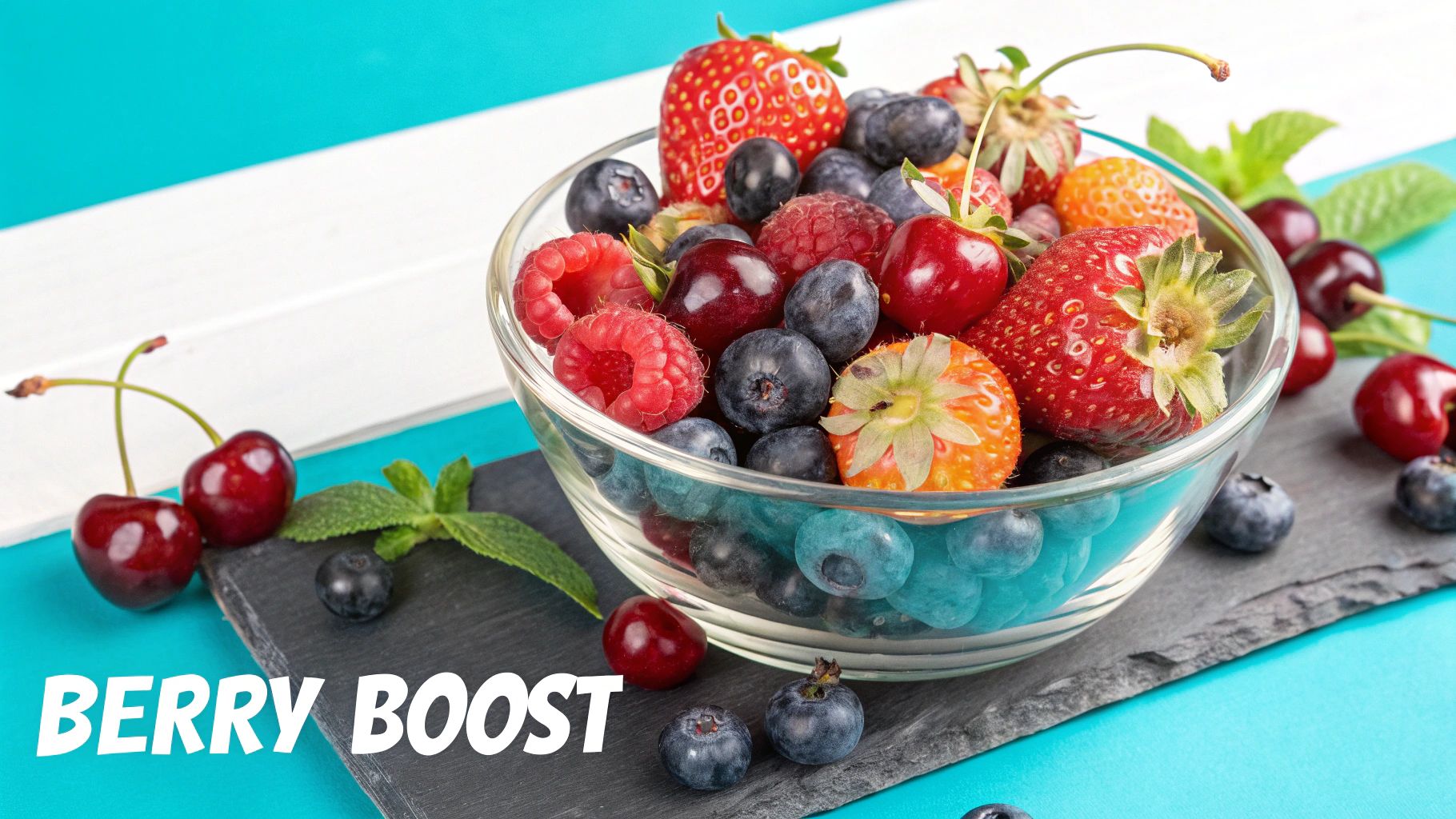

· By Annemarie
Your 2025 Anti Inflammatory Foods List: 10 Foods to Eat
Chronic inflammation is a silent culprit behind many modern health issues, from joint pain and fatigue to more serious long-term conditions. While acute inflammation is a natural and necessary part of the body's healing process, persistent, low-grade inflammation can quietly undermine your overall well-being. The good news is that your kitchen holds one of the most powerful tools for fighting back. This comprehensive guide provides a detailed anti inflammatory foods list, moving beyond generic advice to give you actionable strategies for incorporating these nutritional powerhouses into your daily life.
We will explore ten specific foods, from fatty fish and leafy greens to potent spices like turmeric and ginger. For each item on the list, you will discover the science behind its anti-inflammatory properties, get practical tips for buying and preparing it, and learn simple ways to make it a regular part of your meals. This isn't just a list; it's a roadmap to building a diet that actively supports your body's ability to thrive. Whether you're a busy professional, a frequent traveler, or simply looking to optimize your health, get ready to transform your well-being from the inside out, one delicious and strategic meal at a time.
1. Fatty Fish (Salmon, Sardines, Mackerel)
Topping our anti inflammatory foods list, cold-water fatty fish are a nutritional powerhouse due to their high concentration of omega-3 fatty acids. These essential fats, specifically eicosapentaenoic acid (EPA) and docosahexaenoic acid (DHA), are integral to managing the body's inflammatory response. They work by blocking the production of inflammatory molecules like cytokines and prostaglandins.
Research consistently links the consumption of fatty fish with significant health benefits. For instance, studies on populations following a Mediterranean diet, which is rich in fish, show markedly lower levels of inflammatory markers. Similarly, patients with rheumatoid arthritis often report reduced joint pain and stiffness after incorporating fatty fish into their diets, highlighting its potent effects.
Practical Tips for Incorporation
To maximize benefits, aim for two to three servings (about 3-4 ounces each) per week. When possible, choose wild-caught varieties like Alaskan salmon, as they typically contain higher levels of omega-3s and fewer contaminants than their farmed counterparts. Gentle cooking methods such as baking, steaming, or poaching are recommended to preserve the delicate fatty acids.
This quick reference box summarizes the key data points for incorporating fatty fish into your diet.

As the infographic highlights, a consistent intake of two to three servings per week is the recommended target to achieve significant heart and joint health benefits.
2. Leafy Greens (Spinach, Kale, Arugula)
A cornerstone of any anti inflammatory foods list, dark leafy greens like spinach, kale, and arugula are packed with vitamins, minerals, and powerful antioxidants. Their anti-inflammatory properties are largely attributed to high concentrations of vitamin K, which helps regulate inflammatory proteins, and antioxidants like carotenoids and flavonoids that combat cellular damage caused by oxidative stress. The nitrates found in these greens also improve blood flow and further reduce inflammation.

The benefits are well-documented in various populations. For instance, many Blue Zones communities, known for their longevity, consume leafy greens daily. Athletes often incorporate greens into their diets to speed up recovery and reduce exercise-induced inflammation. Furthermore, individuals with type 2 diabetes have shown improved blood sugar control and reduced inflammatory markers by increasing their intake of these nutrient-dense vegetables.
Practical Tips for Incorporation
Aim to include at least one to two cups of leafy greens in your diet daily. To make them more palatable and boost nutrient absorption, try different preparation methods. For example, massaging kale with a little olive oil and lemon juice can soften its tough texture and reduce bitterness. Blending spinach into smoothies is a simple way to increase your intake without noticing the taste. Lightly sautéing greens with garlic and olive oil can enhance the bioavailability of fat-soluble vitamins like vitamin K. Rotating between different types of greens will provide a wider array of nutrients.
3. Berries (Blueberries, Strawberries, Cherries)
Vibrant and sweet, berries earn a prominent spot on any anti inflammatory foods list thanks to their rich concentration of antioxidants called anthocyanins. These are the plant compounds that give berries like blueberries, strawberries, and cherries their deep red and purple hues. Anthocyanins work to lower inflammation by reducing the body’s production of pro-inflammatory cytokines, making them a powerful tool for cellular health.

The benefits are well-documented across different health contexts. Athletes often turn to tart cherry juice to decrease muscle soreness and inflammation post-exercise, speeding up recovery. Furthermore, research links regular berry consumption to cognitive protection, with studies suggesting they may help fend off age-related memory decline. Their anti-inflammatory action also provides relief for those with arthritis, helping to reduce joint pain and stiffness. Because they are great for rehydration and replenishing vitamins, you can learn more about how berries can help after a night out on enjoyupside.com.
Practical Tips for Incorporation
To harness their anti-inflammatory power, aim to incorporate a cup of mixed berries into your daily routine. Consider buying berries frozen, which preserves their nutritional value and ensures year-round availability at a lower cost. They make an excellent addition to morning oatmeal, yogurt, or blended into a smoothie with leafy greens for a nutrient-packed meal. Choosing organic varieties when possible can also help minimize exposure to pesticide residues.
4. Turmeric
A staple in traditional medicine for centuries, turmeric earns its place on any anti inflammatory foods list due to its active compound, curcumin. Curcumin is a potent polyphenol that directly targets inflammation at a molecular level. It works by blocking the activation of NF-kB, a molecule that travels into the nuclei of cells and turns on genes related to inflammation, effectively switching off the body’s inflammatory alarm system.
The efficacy of curcumin is well-documented. For instance, numerous studies have shown that patients with osteoarthritis experience significant reductions in pain and improvements in function, often comparable to conventional anti-inflammatory drugs. It's also increasingly used in post-surgical recovery protocols to manage swelling and support healing, drawing on principles from Ayurvedic medicine where it has been used for this purpose for thousands of years.
Practical Tips for Incorporation
Curcumin's main challenge is its low bioavailability, meaning the body struggles to absorb it. To overcome this, always pair turmeric with black pepper, as the piperine in pepper can boost curcumin absorption by up to 2,000%. Consuming it with a source of healthy fat, like coconut oil or avocado, also enhances its uptake. Start with small doses, such as a quarter teaspoon, and gradually increase to assess your tolerance.
As this video explains, for those seeking therapeutic doses for conditions like arthritis, a standardized curcumin supplement may be more effective than relying solely on the spice in food. Always consult a healthcare provider before starting a supplement regimen.
5. Extra Virgin Olive Oil
A cornerstone of the Mediterranean diet, extra virgin olive oil is celebrated for its powerful anti-inflammatory properties. Its primary benefit comes from a unique phenolic compound called oleocanthal, which has been shown to work in a similar way to ibuprofen, inhibiting the COX enzymes involved in inflammation. Additionally, it is rich in oleic acid, a monounsaturated fat, along with vitamin E and other polyphenols that combat oxidative stress and reduce systemic inflammation.
The health benefits are well-documented, particularly in populations where olive oil is a dietary staple. Numerous cardiovascular studies link high-quality olive oil consumption to improved heart health markers and lower rates of inflammatory-related diseases. The long-standing culinary traditions of Mediterranean cultures, which have relied on this oil for thousands of years, serve as a testament to its enduring place on any anti inflammatory foods list.
Practical Tips for Incorporation
To harness its full potential, it's crucial to select and use extra virgin olive oil correctly. It is best used for low-to-medium heat cooking or, ideally, as a finishing oil drizzled over salads, vegetables, or soups to preserve its delicate compounds. Aim for one to two tablespoons daily.
When shopping, look for a harvest date on the bottle rather than just an expiration date, and choose oil that is less than two years old. Store it in a cool, dark place away from heat and light to prevent oxidation. Opting for certified "extra virgin" varieties ensures you are getting the highest quality oil with the most potent health benefits.
6. Nuts and Seeds (Walnuts, Flaxseeds, Chia Seeds)
A staple in many healthy eating patterns, nuts and seeds are a vital component of any anti inflammatory foods list. They deliver a potent combination of healthy fats, fiber, and powerful antioxidants. Walnuts are particularly noteworthy for their high concentration of alpha-linolenic acid (ALA), a plant-based omega-3 fatty acid. Similarly, flaxseeds and chia seeds are rich in both ALA and lignans, compounds that exhibit strong anti-inflammatory properties.
These foods work by helping to improve the body's omega-6 to omega-3 fatty acid ratio, a critical balance for controlling systemic inflammation. Studies like the large-scale Nurses' Health Study have linked regular nut consumption to a reduced risk of inflammatory-related conditions like heart disease. The combination of healthy fats and fiber in nuts also makes them an excellent choice for stabilizing blood sugar and providing sustained energy. This is particularly beneficial before certain social activities; for instance, you can learn more about what to eat before drinking to help manage its effects.
Practical Tips for Incorporation
To harness their benefits, aim for a daily serving of about one to two ounces (a small handful). It is best to choose raw or lightly roasted, unsalted varieties to avoid added sodium and damaged fats from high-heat processing. To improve nutrient absorption, consider grinding flaxseeds just before use, as whole seeds can pass through the digestive system intact. Storing all nuts and seeds in the refrigerator or freezer is recommended to prevent their delicate oils from becoming rancid.
7. Tomatoes
A staple in cuisines worldwide, tomatoes earn their spot on any anti inflammatory foods list due to their high concentration of lycopene. Lycopene is a powerful antioxidant carotenoid responsible for the fruit's vibrant red color, and it is known for its ability to neutralize free radicals and combat systemic inflammation. Tomatoes are also an excellent source of vitamin C and potassium, further supporting the body's defenses against inflammatory processes.
The health benefits of tomatoes, particularly cooked ones, are well-documented. For instance, extensive research pioneered by experts like Dr. Edward Giovannucci has linked high lycopene intake with a reduced risk of certain cancers, notably prostate cancer. Furthermore, Mediterranean populations, who consume large quantities of cooked tomatoes in sauces and stews, exhibit lower rates of cardiovascular disease, which is often tied to chronic inflammation.
Practical Tips for Incorporation
To boost the anti-inflammatory benefits, focus on cooked tomato products, as the heating process makes lycopene more bioavailable. Aim to include tomatoes in your diet several times per week. For an added advantage, pair tomatoes with a healthy fat like olive oil, which significantly enhances the absorption of fat-soluble lycopene. Store fresh, ripe tomatoes at room temperature away from direct sunlight to preserve their flavor and nutrient profile. Using concentrated tomato paste is an easy way to add a potent dose of lycopene to soups, sauces, and stews.
8. Green Tea
A staple in traditional Chinese and Japanese medicine, green tea earns its spot on any anti inflammatory foods list due to its high concentration of epigallocatechin gallate (EGCG). This powerful polyphenol is a potent antioxidant with well-documented anti-inflammatory properties. Unlike black tea, green tea is minimally processed, which preserves these beneficial compounds that work by reducing the production of pro-inflammatory cytokines.
The health benefits are evident in populations with high green tea consumption, like in Japan, where rates of inflammatory diseases are historically lower. Research also links regular intake with a reduced risk of certain chronic diseases and benefits in weight management. The EGCG in green tea effectively interrupts pathways that lead to inflammation, making it a powerful beverage for cellular health. Interestingly, some of the compounds that help with inflammation may also play a role in how the body processes alcohol; you can find more information about foods that help with hangovers on enjoyupside.com.
Practical Tips for Incorporation
To harness green tea's benefits, aim to drink two to three cups daily. It's best consumed between meals, as drinking it with food can sometimes interfere with the absorption of iron from plant-based sources. For a better brew, steep the leaves for only 2-3 minutes in water that is hot but not boiling (around 175°F or 80°C) to avoid releasing bitter-tasting tannins.
Consider these additional tips:
- Choose organic varieties when possible to minimize pesticide exposure.
- Add a squeeze of lemon juice, as the vitamin C can enhance your body's ability to absorb the beneficial catechins.
9. Avocados
Avocados are a unique and valuable addition to any anti inflammatory foods list. Unlike most fruits, they are packed with healthy monounsaturated fats, particularly oleic acid, which has been shown to reduce inflammatory markers. They are also an excellent source of fiber, potassium, and magnesium, all of which play roles in regulating the body's inflammatory processes and supporting overall metabolic health.
The powerful anti-inflammatory effects of avocados are backed by significant research. For example, studies have shown that adding avocado to a meal can blunt the post-meal inflammatory response that might otherwise occur, especially after consuming less healthy foods. Furthermore, the combination of healthy fats and antioxidants like carotenoids in avocados works synergistically. Their fat content dramatically increases the absorption of these beneficial compounds from other plant foods eaten alongside them, amplifying their anti-inflammatory potential.
Practical Tips for Incorporation
To harness their benefits, aim to incorporate half an avocado into your daily routine. It's a versatile food that can be easily added to various meals. Use sliced avocado as a creamy replacement for mayonnaise on sandwiches or butter on toast. Adding it to salads not only boosts flavor and texture but also helps you absorb more nutrients from the vegetables.
To keep a cut avocado from browning, simply brush the exposed flesh with a little lemon or lime juice. For a powerful synergistic effect, combine avocados with tomatoes, as the healthy fats in the avocado enhance your body's absorption of the lycopene, a potent antioxidant found in tomatoes. This simple pairing creates a delicious and effective anti-inflammatory combination.
10. Ginger
A staple in traditional medicine for centuries, ginger earns its spot on any anti inflammatory foods list due to its powerful bioactive compounds. This pungent root contains gingerols and shogaols, which have demonstrated potent anti-inflammatory and antioxidant effects. These compounds work by inhibiting the production of certain pro-inflammatory molecules, helping to soothe inflammation throughout the body.
The efficacy of ginger is supported by extensive research. It has been shown to be effective in managing conditions like osteoarthritis, with studies indicating that ginger extracts can significantly reduce pain and stiffness in joints. Other research highlights its role in reducing post-exercise muscle soreness and even alleviating pregnancy-related nausea, showcasing its versatile therapeutic applications.
Practical Tips for Incorporation
To harness its full benefits, try to incorporate ginger into your diet regularly. Fresh ginger root is generally considered more potent than dried or powdered forms, but both offer substantial benefits. Start with small amounts, such as a half-inch piece, to assess your tolerance before increasing consumption.
Here are a few simple ways to add it to your routine:
- Grate fresh, peeled ginger into stir-fries, soups, or marinades.
- Steep slices of fresh ginger in hot water to create a soothing, anti-inflammatory tea.
- Add a small piece of fresh ginger or a dash of ginger powder to your morning smoothie for a zesty, health-boosting kick.
Anti-Inflammatory Foods Comparison Summary
| Item | Implementation Complexity 🔄 | Resource Requirements ⚡ | Expected Outcomes 📊 | Ideal Use Cases 💡 | Key Advantages ⭐ |
|---|---|---|---|---|---|
| Fatty Fish (Salmon, Sardines, Mackerel) | Moderate (requires cooking & storage) | Moderate to high (cost, freshness) | Significant inflammation reduction, heart & joint health | Reducing chronic inflammation, arthritis, heart health | Rich in EPA/DHA omega-3s, clinically proven benefits |
| Leafy Greens (Spinach, Kale, Arugula) | Low (easy prep, raw or cooked) | Low (widely available, affordable) | Antioxidant support, bone & cardiovascular health | Daily nutrition, recovery, broad anti-inflammatory support | Nutrient-dense, versatile, affordable |
| Berries (Blueberries, Strawberries, Cherries) | Low (ready-to-eat, minimal prep) | Moderate (cost varies, seasonal) | Reduced inflammatory markers, cognitive & exercise recovery | Immune support, cognitive benefits, post-exercise recovery | High anthocyanins, antioxidant-rich, tasty |
| Turmeric | Low to moderate (spice use, supplementation) | Low (inexpensive spice) | Potent inflammation inhibition, immune modulation | Arthritis management, liver support, traditional medicine | Powerful curcumin compound, well-studied |
| Extra Virgin Olive Oil | Low (simple use in cooking/dressing) | Moderate (quality-dependent cost) | Cardiovascular health support, anti-inflammatory effects | Mediterranean diet, heart health, cooking flavor enhancement | Oleocanthal compound, versatile, heart-healthy |
| Nuts and Seeds (Walnuts, Flaxseeds, Chia Seeds) | Low (snacking or added to meals) | Moderate (cost, storage needs) | Balanced omega-3 intake, satiety, heart & brain support | Snacks, baking, omega-3 balance | Plant-based omega-3s, long shelf life, convenient |
| Tomatoes | Low (cooking or raw) | Low (widely available, inexpensive) | Lycopene antioxidant effects, cancer & heart health | Cooking to boost lycopene, year-round use | Increased lycopene when cooked, versatile |
| Green Tea | Low (brewing required) | Low (affordable, widely available) | Anti-inflammatory, metabolism boost, brain support | Daily beverage, weight management, cognitive health | Rich EGCG polyphenols, mild caffeine |
| Avocados | Low (minimal prep) | Moderate (cost, ripening needs) | Anti-inflammatory fats, nutrient absorption, satiety | Fat replacement, nutrient synergy, heart health | High oleic acid, fiber-rich, nutrient absorption |
| Ginger | Low (fresh or dried use) | Low (inexpensive, easy to store) | Anti-inflammatory, digestive support, nausea relief | Digestive health, nausea, muscle recovery | Potent bioactives, warming, natural COX-2 inhibitor |
Putting It All Together: Your Action Plan for an Anti-Inflammatory Lifestyle
Navigating the world of nutrition can feel overwhelming, but building a diet that combats chronic inflammation is one of the most powerful steps you can take for your long-term health. This comprehensive anti inflammatory foods list is more than just a collection of ingredients; it's a strategic toolkit designed to help you reclaim your vitality, one meal at a time. By focusing on whole, nutrient-dense foods, you empower your body to manage its inflammatory responses effectively.
The true value of this list lies not in memorizing every item, but in understanding the core principles. From the omega-3 fatty acids in salmon and walnuts to the potent antioxidants in berries, leafy greens, and green tea, each food offers a unique mechanism to protect your cells. The goal isn't dietary perfection but consistent, positive progress.
Your Actionable Next Steps
Making lasting changes begins with small, manageable actions. Instead of a complete dietary overhaul, focus on simple, high-impact swaps and additions. Here’s a practical plan to get started this week:
- Focus on Addition, Not Subtraction: Begin by adding two or three new foods from our list to your daily routine. Perhaps it's a handful of walnuts for a snack, a sprinkle of turmeric in your morning scramble, or a side of spinach with dinner. This positive framing makes healthy eating feel like an upgrade, not a restriction.
- Upgrade Your Fats: Identify one source of processed fat in your diet, like vegetable oil or margarine, and replace it with a healthier alternative. Drizzle extra virgin olive oil on your salads or cook with avocado oil to introduce powerful anti-inflammatory compounds.
- Build a Colorful Plate: Use color as your guide. Aim to include at least two different colors from our list in every meal. Think vibrant red tomatoes, deep green kale, and brilliant blue blueberries. A colorful plate is a strong indicator of a nutrient-diverse, inflammation-fighting meal.
Beyond the Plate: A Holistic Approach
While your diet is a cornerstone of managing inflammation, it works best as part of a holistic lifestyle. Factors like chronic stress, poor sleep, and a sedentary routine can all trigger or worsen inflammatory processes, undermining even the healthiest eating habits. For busy professionals and frequent travelers, this balance is especially crucial.
Even with the best intentions, social events and celebrations can introduce inflammatory triggers like alcohol. For nightlife enthusiasts and social drinkers, this doesn't mean you have to miss out. Instead, it highlights the importance of having a recovery strategy. Supporting your body’s natural detoxification pathways becomes paramount after an indulgent evening.
Adopting an anti-inflammatory lifestyle is a journey of continuous improvement. By integrating the foods from this list, making mindful lifestyle choices, and utilizing smart support systems, you are building a resilient foundation for vibrant health. It's about taking proactive control, nourishing your body from the inside out, and ensuring you can live your life to the fullest.
For those times when your social life and health goals intersect, give your body the backup it deserves. Upside Hangover Sticks are formulated with natural, science-backed ingredients to support your body's recovery and detoxification processes after drinking. Discover how Upside Hangover Sticks can be your smart companion for a balanced lifestyle.
